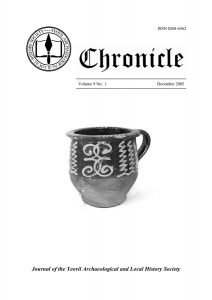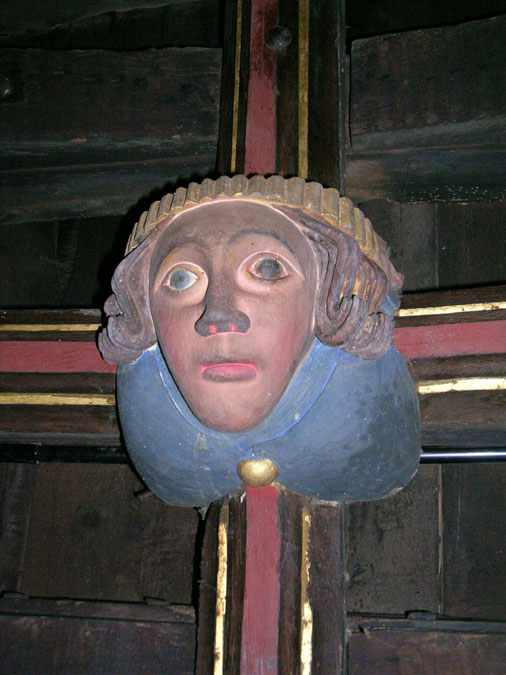
This article came from the Chronicle published November 2005. Pages 12-13
Combe St Nicholas Church In Death They Were Not Divided
Author: Jack Sweet
For over a thousand years this has been a place of worship on the eastern slopes of the Blackdown Hills. The present church of St Nicholas, built at the beginning of the thirteenth-century, was enlarged in the 15th on the proceeds of the wool trade and has remained little changed since that time. The main entrance to the church is through a pair of large iron gates from the village street just south of the square, and the fine tombs tell of the prosperity of many generations past.
However, the village and its setting against the background of hills and woods, becomes a little sinister following the warning inscribed on the tomb of William Aplin in 1815 which tells the reader that:
Dangers stand thick through all the ground
To rush us to the tomb
And fierce diseases wait around
To hurry mortals home.
For two brothers, Maurice and Edward Bethell, remembered on the wall of the north aisle, there were dangers thick enough to daunt the strongest heart a century later on the watery wastes of the North Sea and in the mud and blood of the Western Front.
The Battle of Jutland was fought on the North Sea during the afternoon and evening of 31st May 1916 and was the only time during the First World War when the great battle fleets of the British and German empires met in conflict. At about 3.45 pm on that date, the battle cruisers scouting ahead of both fleets opened fire on each other, and so began the contest which both navies had eagerly awaited. When the battle was over, some eight hours later, the German High Seas Fleet returned to harbour claiming a tactical victory because it had sunk more of the Royal Navy’s ships, but in turn , the British claimed a strategic victory because the Germans had been forced to retire, and never challenged the Royal Navy again during the war.
It was during the early stages of the battle that HMS Nestor, a destroyer in which Maurice Bethell was serving as First Lieutenant, found fame. The twelve ships of the Royal Navy’s 13th Destroyer Flotilla, led by Commander the Hon. Edward Bingham in Nestor, were launched in a torpedo attack on the enemy battle cruisers, but at the same time, 15 German destroyers, led by a light cruiser, attacked the British. A fierce engagement took place and two German destroyers were sunk. The rest were driven off with no loss to the Royal Navy but the British destroyers were scattered over a wide area, thereby reducing the weight of their torpedo attack on the enemy battle cruisers. However, Commander Bingham returned the attack and Nestor, supported by HMS Nicator and HMS Nomad, charged at top speed towards their huge opponents. Each ship fired two torpedos but no hits were registered as their aim was thrown out by the pitching and rolling of the sea churned up by the great warships and exploding shells. The 6 inch guns of the German battle cruisers’ secondary armament soon found the range and shells poured down on the audacious little ships. Nomad was hit and stopped dead in the water with her engine room a shambles but Nestor, now joined by Nicator and HMS Petard, pressed on. More torpedos were fired, but only Petard scored a hit on the battle cruiser Seydlitz, and then Nestor was hit. A shell exploded in her engine room and, as clouds of steam poured from the smashed boilers, the crippled destroyer swung hard to starboard, narrowly avoiding a collision with Nicator. She wallowed helplessly some four miles from the disabled Nomad but, as the battle moved away, the two ships were spared further damage. However, the reprieve was short because, over the southern horizon, came the German High Seas Fleet.
Remorselessly, the huge battleships bore down on the two small destroyers lying in their path and once again shells fell around them. Nomad was smashed and sank, then came the turn of Nestor. With German shells bracketing his ship, Commander Bingham defiantly ordered the last torpedo to be fired, even though there was little chance of it finding a target. Hits were now being registered on Nestor, turning her into a shambles of torn metal and, as she began to sink, the order was given to abandon ship.
In his book Falklands, Jutland and the Bight, Edward Bingham wrote that during the last moments of Nestor, Lieutenant Bethell had been organising the launching of boats and life rafts and had reported the successful completion of this operation. Commander Bingham recalled that he had called out to his First Officer ‘Now where shall we go?’ to which Bethell’s reply was, ‘To heaven I trust, Sir!’ This answer, Bingham wrote, ‘was characteristic of that gallant spirit and at that moment Bethell turned aside to attend to a mortally wounded signalman and was seen no more amidst a cloud of fumes from a bursting shell.’ Commander Bingham and 80 members of Nestor’s company survived and were eventually rescued by a German warship, to spend the rest of the was as prisoners.
For his courage in leading the attack on the German battle cruisers, Commander Bingham was awarded the Victoria Cross, one of four won at the Battle of Jutland.
The death of Captain Edward Bethell seems doubly tragic. After being severely wounded near Ypres in 1914 and surviving the horrific battles of the first months of the war, he returned to active service in July 1918, only to die within weeks of its end. On 21st September 1918, the Queen’s Regiment (Royal West Surreys) in which Edward Bethell was a company commander, was taking part in the great assault on the German Hindenberg Line, south west of Cambrai. Together with the London and Eastern Counties Battalions, the fought their way into the enemy’s outposts and defensive systems in the villages of Epehy and Ronssoy. By midday on 21st, they had established a line some three miles in length but during the afternoon, in rain and oncoming darkness, the Germans launched fierce counter attacks, recapturing much of their lost territory. The British put in a new attack and by early dawn on 22nd September, had succeeded in retaking about a mile of the German trenches. It was during this savage fighting that Captain Edward Bethell fell, leading his men and on 21st September 1918 the brothers were no longer divided.
In July 1685, the ‘Queen’s Regiment’, recently returned from hard campaigning in Tangier and commanded by Colonel Percy Kirke, formed part of the Royal Army which fought the Monmouth Rebels at Sedgemoor and gained notoriety for the severity with which the pursued and dealt with the followers of the ill-fated Duke. ‘Kirke’s Lambs’, nicknamed after the Pascal Lamb shown on the regimental colours, became the Queen’s Regiment (Royal West Surreys) – Edward Bethell’s regiment.
